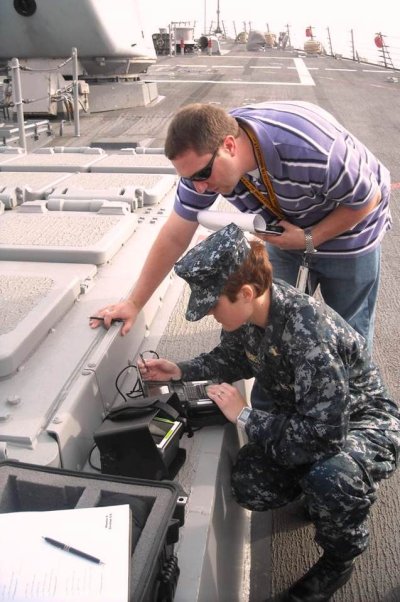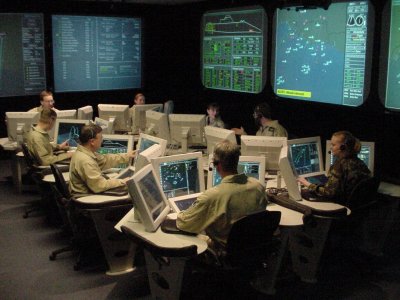
Justin Kingsford, Naval Surface Warfare Center Dahlgren Division (NSWCDD) Human Systems Engineer, works with a Navy officer to conduct usability testing on the AN/PYX-1 Identity Dominance System aboard USS Oscar Austin (DDG-79) in Norfolk, Va. The system collects biometrics such as face, finger, and iris images, and enrolls that information into a local database to match against known persons of interest. Once the information has been captured, the system sends the information back to the authoritative data base. Kingsford, NSWCDD HSI Deputy Program Director, and his team support a wide range of science and technology initiatives that include human interaction devices and interfaces, 3D gestural controls, adaptive projection augmented models, unmanned systems, and next generation weapons integration. (U.S. Navy Photo/Released)
DAHLGREN, Va.—How is Navy science and technology impacting the capabilities that Sailors need to fight, win and come home safely - now and in the future?
Military, business and academic minds pondering that question received new insight from Navy leaders at the 26th Surface Navy Association (SNA) National Symposium over the course of a week in January.
However, they left the annual event with answers that only Navy scientists and engineers who design and develop ships' combat systems could provide.
Two Naval Surface Warfare Center (NSWCDD) civilians reflected on their answers about surface warfare technologies enabling Sailors to deliver prompt, sustained combat power today, tomorrow, and in the future.
The NSWCDD Human System Integration (HSI) engineers, Jon Dachos and Betsy Khol, also recounted Navy HSI plans to make the symposium's theme - "Surface Warfare-Warfighting First" - a reality.
"From an HSI perspective, it was very satisfying to see many of the vendors had alignment of naval science and technology with naval missions and future capability needs for operators," said Jon Dachos, NSWCDD HSI Command Center design lead engineer. "I enjoyed seeing how usability of a system is a greater part of the design system engineer process for new capabilities. It shows that HSI is gaining traction in Department of Defense systems."
The Navy's HSI process includes modeling and simulation, mock-up (small and large scale), 3D human factors engineered CAD (computer-aided design) walkthroughs, and fleet participation in warfare scenarios with Sailors' verifying the design layout of combat direction centers on warships, including aircraft carriers such as USS Gerald R. Ford (CVN 78).
"It was very exciting to see that many companies are developing products and technologies that have more focus on usability for warfighters and operators," said NSWCDD HSI engineer Betsy Khol. "Dahlgren's HSI team is able to serve as an advocate for the warfighter to ensure a design's impact on the user is considered either before or after a capability is deployed to the fleet."
NSWCDD scientists and engineers exhibited a myriad of technologies and capabilities developed to support the warfighter in collaboration with other Naval Sea System Command warfare centers as well as vendors representing industries at the symposium.
"It is great to see many vendors taking the initiative to incorporate usability and user experience into an initial design and recognizing the importance of user-centered design on the warfighter," said Khol.
Dachos and Khol are among HSI scientists and engineers based at NSWCDD with HSI facilities that include the Integrated Command Environment (ICE) and Human Performance Laboratory (HPL).
They informed SNA attendees about the ICE/HPL facilities and the command's partnership with the Center for Surface Combatant Systems (CSCS) and the Aegis Training and Readiness Center (ATRC) in Dahlgren, Va. This partnership provides a valuable link between science and technology, research and development activities, and the acquisition and Fleet communities.
"The Human Systems Integration Branch at NSWCDD currently provides Fleet and Warfighter support to more than 100 naval programs," said John Schultz, NSWCDD Acting HSI Branch Head. "The projects range in size from large scale acquisition programs such as littoral combat ship and joint light tactical vehicle, down to one time evaluations of Marine Corps information systems."

Naval reservists, scientists and engineers work in the Integrated Command Environment (ICE) Human Performance laboratory located at Naval Surface Warfare Center Dahlgren Division (NSWCDD). In 2014, the ICE lab (revamped since this photo) continues to focus on the Navy's evolving human performance and human systems integration (HSI) testing. The lab demonstrates the ability to fight future battles with HSI - engineered hardware, software and features common consoles, displays, and knowledge management features that Sailors helped design to enhance human performance and mission accomplishment. The HSI Branch also supports a wide range of science and technology initiatives that include human interaction devices and interfaces, 3D gestural controls, adaptive projection augmented models, unmanned systems, and next generation weapons integration. (U.S. Navy Photo/Released)
The HSI Branch supports a wide range of science and technology initiatives that include human interaction devices and interfaces, 3D gestural controls, adaptive projection augmented models, unmanned systems, and next generation weapons integration.
Their research and interaction with Sailors about operational needs ensures Fleet interest and participation and a clear transition path. Feedback from Sailors - about 1,500 officer and enlisted participants in the last five years - combined with solid human systems engineering expertise have been key to the success of the HSI team at Dahlgren.
"We are committed to identifying cutting edge technologies and solutions that can decrease operator workload and increase situational awareness in the ever increasing complexity of naval systems," said Schultz.
The HSI team's focus is human performance, stressing optimization of manpower, usability, maintainability, decision support, and knowledge superiority in an effort to enhance Sailors' capabilities and improve total system performance and affordability over the entire life-cycle of a platform or system. A sound, systems engineering approach is applied to problems, emphasizing that a system is not only composed of hardware and software but also includes the human operators, maintainers, decision makers, and the shore support infrastructure manpower.
The Surface Navy Association was established in 1985 to promote greater coordination and communication among those in the military, business and academic communities who share a common interest in Naval Surface Warfare and to support the activities of Surface Naval Forces.

